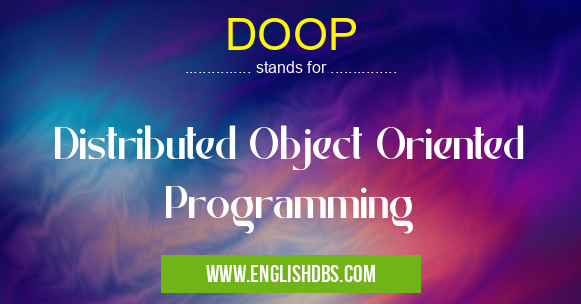What does DOOP mean in SOFTWARE
DOOP stands for Distributed Object Oriented Programming and is a paradigm of programming that enables the creation of distributed systems by extending the principles of object-oriented programming (OOP) to the distributed environment. In other words, DOOP allows objects to be created, used, and managed across multiple computers or nodes connected over a network, enabling the development of complex distributed applications.

DOOP meaning in Software in Computing
DOOP mostly used in an acronym Software in Category Computing that means Distributed Object Oriented Programming
Shorthand: DOOP,
Full Form: Distributed Object Oriented Programming
For more information of "Distributed Object Oriented Programming", see the section below.
Key Features of DOOP
- Object Distribution: DOOP provides the ability to distribute objects across multiple nodes in a distributed system, allowing for efficient resource utilization and scalability.
- Transparency: DOOP aims to hide the distribution details from the programmer, making it easier to develop and maintain distributed applications.
- Concurrency Control: DOOP provides mechanisms for managing concurrent access to shared objects, ensuring data integrity and consistency in a distributed environment.
- Fault Tolerance: DOOP systems are designed to be fault-tolerant, handling failures gracefully and ensuring the availability of services even in the event of node failures.
Benefits of DOOP
- Scalability: DOOP enables the creation of highly scalable distributed systems by allowing objects to be distributed across multiple computers.
- Flexibility: DOOP provides a flexible approach to developing distributed applications, allowing for the independent deployment, modification, and replacement of objects without affecting the rest of the system.
- Code Reusability: DOOP encourages code reuse by allowing objects to be shared across different applications and systems.
- Improved Performance: DOOP can improve performance by distributing the workload across multiple nodes, reducing the load on individual computers.
Essential Questions and Answers on Distributed Object Oriented Programming in "COMPUTING»SOFTWARE"
What is Distributed Object Oriented Programming (DOOP)?
DOOP is a programming paradigm that allows objects to be distributed across multiple computers or processors, enabling them to communicate and collaborate over a network.
What are the benefits of using DOOP?
DOOP offers several benefits, including:
- Scalability: DOOP allows systems to be scaled horizontally by adding more nodes to the network, enabling them to handle increased load and complexity.
- Concurrency: DOOP enables objects to execute concurrently, improving performance and responsiveness by allowing multiple tasks to run simultaneously.
- Flexibility: DOOP makes it easier to modify and update systems by allowing objects to be deployed and redeployed independently, reducing the impact on the overall system.
What is the difference between DOOP and RPC (Remote Procedure Call)?
DOOP differs from RPC in several ways:
- Object-oriented: DOOP is object-oriented, meaning that it allows objects to interact with each other through method calls.
- Transparency: DOOP provides location transparency, meaning that objects can be accessed regardless of their physical location on the network.
- State management: DOOP allows objects to maintain their own state, which is managed by the object itself rather than the caller.
What are some examples of DOOP frameworks?
Several popular DOOP frameworks exist, including:
- CORBA (Common Object Request Broker Architecture): A widely used standard for distributed object computing.
- DCOM (Distributed Component Object Model): A proprietary framework developed by Microsoft.
- Java RMI (Remote Method Invocation): A framework built into the Java programming language.
How is DOOP used in real-world applications?
DOOP is used in a variety of applications, including:
- Enterprise software: DOOP is used in enterprise software systems to enable distributed computing, such as in distributed databases and message brokers.
- Cloud computing: DOOP is used in cloud computing environments to enable distributed processing and resource sharing.
- Web services: DOOP is used to implement web services, which allow applications to communicate and exchange data over the internet.
Final Words: DOOP is a powerful paradigm for developing distributed systems that offer scalability, flexibility, code reusability, and improved performance. By extending the principles of OOP to the distributed environment, DOOP simplifies the development and maintenance of complex distributed applications and enables the creation of robust and reliable systems.
